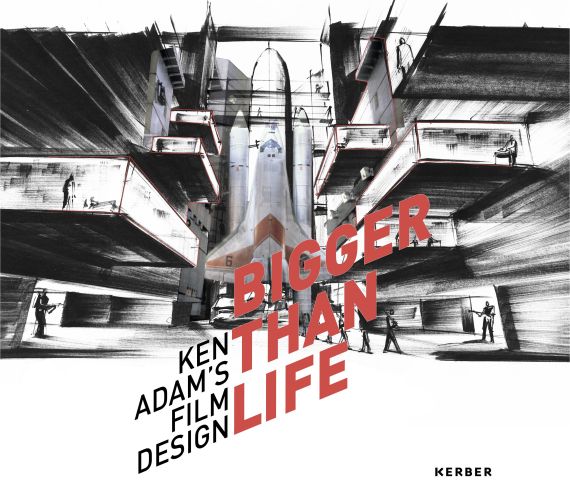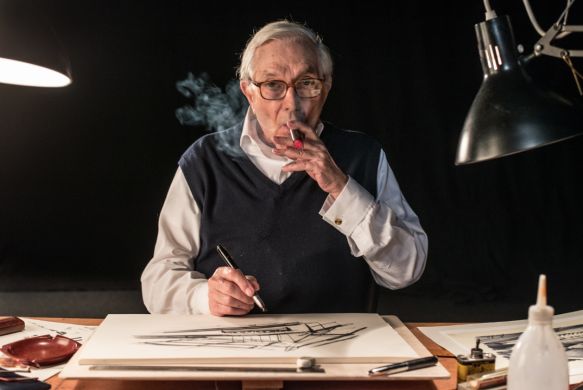
Sir Ken Adam in Lines in Flow, 2014. An Installation by Boris Hars-Tschachotin
Photo/©: Andreas-Michael Velten
Bigger Than Life – Ken Adam’s Film Design
11.12.14 – 17.5.15
-
Publikation
The production designer Sir Ken Adam has written film history with his spectacular sets. He was responsible for the production design of more than 70 films. Few of his colleagues can match his abilities to design such diverse worlds. Through his scenographic spaces, mostly realized in the studio, he created a new style that has lastingly influenced our viewing habits. True to his design philosophy “bigger than life,” Adam used his work to push the boundaries of what is possible – often highly emotionally, occasionally playful or humorously, and yet always believably. Each of his films has been characterized by a very strong visual succinctness and ripple effect. Adam has received numerous awards for his work, including two Academy Awards (Oscars) for Best Production Design for the films Barry Lyndon (Stanley Kubrick, 1975) and The Madness of King George (Nicholas Hytner, 1994).
Ken Adam’s oeuvre is comprised of more than 5,000 drawings. These are augmented by other objects, including photographs, but also films that Adam shot while conducting research and on the sets, as well as personal, biographical memorabilia and his awards. Ken Adam gave his collection to the Deutsche Kinemathek in 2012. This trust and confidence in a Berlin institution is also a gesture of reconciliation from the man who was born in Berlin in 1921 as Klaus Hugo Adam, but who the National Socialists drove out of Germany together with his family. It is Adam’s wish that his work should be used to inspire subsequent generations. Ken Adam’s archive is currently being inventoried and prepared for archival use. It will be available online in autumn 2015.
Key Aspects
Ken Adam's World
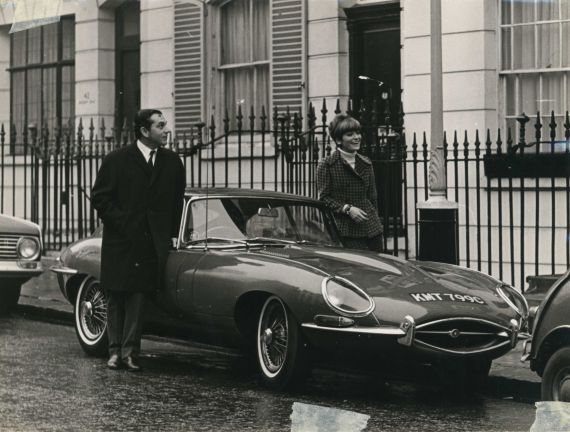
Ken and Letizia Adam, around 1964
Source: Deutsche Kinemathek - Ken Adam Archiv
From Berlin (via London) to Hollywood: Following his flight from his native country under National Socialism, and his voluntary service as a fighter pilot with the Royal Air Force in World War II, Ken Adam’s work in the film industry signified for him both new freedom and an exploration of the world. He met Letizia Moauro during film production on the island of Ischia in 1951. The couple married the following year and she has been his most important adviser ever since.
Letizia Adam also encouraged her husband to use a reduced, but nevertheless dynamic drawing style, with which he has designed film sets since the end of the 1950s. Using his new tool, a Flo-Master felt-tip pen, he sketched vibrantly energetic spaces that are unmistakably his own.
Adam’s work on more than 70 feature films, including some exotic locations, turned the couple into global citizens and correspondingly into members of the jet set. Ken Adam worked in Hollywood in the 1980s and 1990s, where his house was frequented by movie celebrities.
The Adams now live in London again, where Ken Adam continued to work at his drawing table and preserved the collection of his designs until he entrusted them to the Deutsche Kinemathek.
"Lines in Flow"
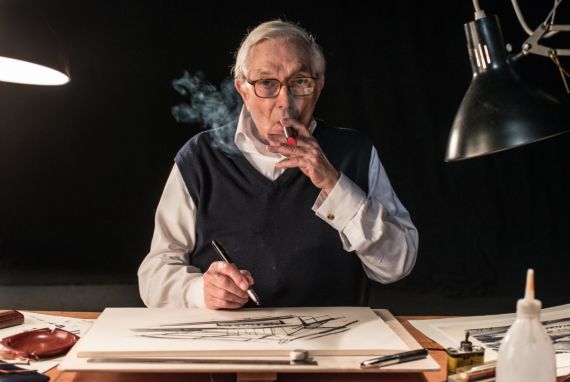
Sir Ken Adam in Lines in Flow, 2014. An Installation by Boris Hars-Tschachotin
Photo/©: Andreas-Michael Velten
An Installation by Boris Hars-Tschachotin
Lines in Flow plays with the idea that Ken Adam might be found sitting at his drawing table in the Shepperton Studios near London. Smoking a cigar, he conjures up the year 1962.
Ken Adam has picked up his Flo-Master again for this installation, at age 93. Before the eyes of viewers, he uses his felt-tip pen to recreate his designs of a nuclear blastproof conference room located below the Pentagon; his iconic “War Room” from Dr Strangelove or: How I Learned to Stop Worrying and Love the Bomb (Stanley Kubrick, 1964). While drawing, he talks about the fundamental spatial metamorphosis that this center of power went through.
The installation takes an in-depth look at drawing as a production designer’s creative means of expression, while providing insights into the process involved in designing cinematic spaces. Five of the 14 drawings still preserved for the “War Room” were redrawn and animated for this purpose. A reverse process that Adam had repeatedly put into practice was applied. Referring to this technique, Adam commented: “These ‘negative’ drawings were highly inspiring.”
Spatial Visions
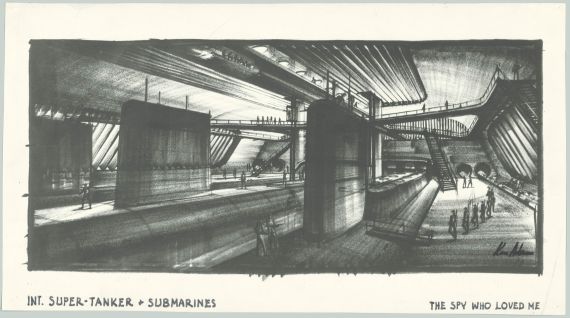
Design sketch supertanker Liparus, The Spy Who Loved Me (UK/USA 1977, directed by Lewis Gilbert)
© Sir Ken Adam, Source: Deutsche Kinemathek – Ken Adam Archiv
Ken Adam’s dynamic and expressive drawings often show unfathomable, exotic and nightmarish places drawn with the highest intensity. His designs are repeatedly based on concise geometric forms: the asymmetric triangle, the distorted rectangle and the circle. He dramatically stages light and shadow to create stylistic space. At the same time, Adam aestheticizes modern technology and often experiments with unusual materials and metallic surfaces, such as copper, brass or even plastic.
The broad spectrum of Adam’s œuvre is illustrated by clusters of motifs. They show dangerous dungeons and laboratories, elegant villas and apartments, gigantic headquarters of power and conference rooms, as well as monumental temples and cathedrals. These are enhanced by playful and dangerous water vehicles and aircraft that are fully equipped with modern gadgets – including speedboats, amphibious vehicles and laser-powered satellites.
A model has been conceived and built for each theme as a visualization corresponding to Adam’s design language. Based on his drawings, Adam’s typical spatial environments have been converted into three-dimensional spaces that provide tangible insights into the functions and effects of his designs.
Reproduced works of fine art, architecture and design allow for stylistic classification, while illustrating the influences, parallels and the impact of his work.
Berlin and London
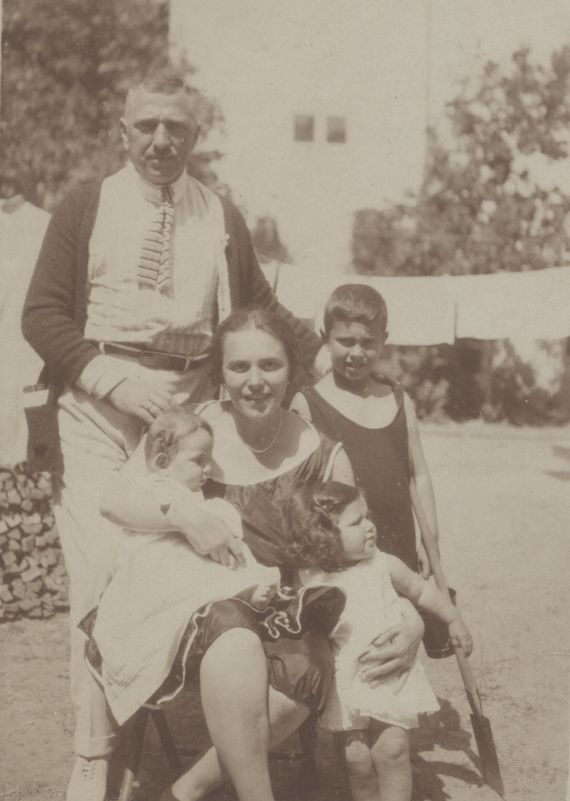
The Adam family: Fritz, Lilli, Klaus, Loni and Peter in Berlin, 1921
Source: Courtesy of the Charlton Family, London
Klaus Hugo Adam was born in Berlin in 1921, into an assimilated, upper-middle-class Jewish family. He grew up in the Tiergarten district. His father, Fritz Adam, and his uncles owned and operated “S. Adam,” an exclusive sporting goods and clothing store on Leipziger Straße.
Fritz Adam had silent film stars pose in sports fashions in the 1920s as advertising for his business. He also supplied props and clothing for films by Murnau and Pabst. The National Socialist assumption of power in 1933 put an abrupt end to a happy childhood. Klaus’ older brother Peter persuaded their father of the necessity of emigration, and the family succeeded in making a modest new start in London. Klaus’ mother Lilli ran a boarding house, which became a meeting place for doctors, actors and musicians – also émigrés. Fritz Adam, who had fought in World War I as a German officer, did not overcome the effects of exile. He died in 1936 at the age of 56. Key biographical milestones that have influenced Ken Adam’s oeuvre include: His school education at the Französisches Gymnasium in Berlin and at St. Paul’s School in London; his studies at the Bartlett School of Architecture; his service as a fighter pilot; the “golden twenties” in Berlin; the “Swinging London” of the 1960s.
He made references to Bauhaus architecture or to Expressionist German film again and again, and erected a monument to his new hometown through his production designs for the Harry Palmer films of the 1960s, filmed on location in London. Ken Adam was made an honorary citizen of Berlin in 2012, although even in the years before, his birth city had become a place that Ken and Letizia Adam gladly and repeatedly visited.
Inspiration and Impact
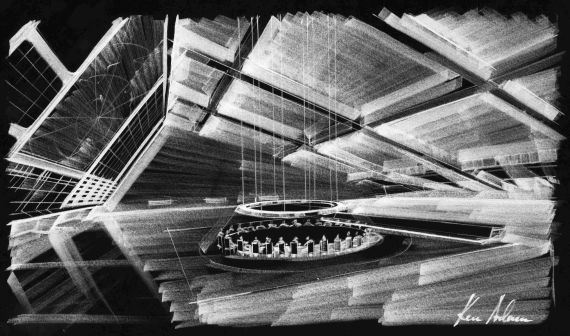
Design sketch War Room, Dr. Strangelove (UK/USA 1964, directed by Stanley Kubrick)
© Sir Ken Adam; Source: Deutsche Kinemathek – Ken Adam Archiv
Drawings allow artists and architects to create suggestive spaces and visionary architecture. Lines are used to create form, materiality and atmosphere. These visual ideas seem to exist in dialogue with one another across time.
Ken Adam was shaped by his childhood in Berlin and studies of architecture in London. He was already familiar with Erich Mendelsohn’s buildings and Mies van der Rohe’s designs from Berlin. In London he studied the architects of the Russian avant-garde and the Bauhaus. Many of these influences in modified form have had an impact on Adam’s use of imagery. In turn, his own style substantially influenced the design and architectural concepts of a subsequent generation of artists. References to Adam’s architectural designs can be recognized in the buildings of Daniel Libeskind and Santiago Calatrava. The architect Norman Foster claimed that Adam’s set of the supertanker for The Spy Who Loved Me (1977) inspired the design of his Canary Wharf tube (Underground) station in London. Even contemporary production designers, like Alex McDowell and Thérèse DePrez, have found new impulses through Ken Adam’s working methods.
Gallery
Credits
Exhibition
Artistic Director: Rainer Rother
Administrative Director: Maximilian Müllner
Curators: Boris Hars-Tschachotin, Kristina Jaspers, Peter Mänz
Project management: Kristina Jaspers, Peter Mänz
Exhibition coordination: Vera Thomas
Fundraising: Boris Hars-Tschachotin
Audiovisual media program: Nils Warnecke
Exhibition assistance: Georg Simbeni, Tim Lindemann
Ken Adam Archiv: Silke Ronneburg (coordination), Jessica Sandrock,
Anett Sawall (inventorying), Mia Golfels (assistance)
Online Presentation of the Ken Adam Archiv: Christiane Grün (project coordination), Clara Holler, Sandra Schieke (digitization)
Finance: Uwe Meder-Seidel
Text editing: Rolf Aurich
English translations: Wendy Wallis, Transart, Berlin
Scans: Julia Riedel
Image rights: Annika Schaefer, Vera Thomas
Design of the advertising graphics: Pentagram Design, Berlin
Design of the exhibition graphics: Jan Drehmel, Befreite Module, Berlin
Design of the exhibition architecture: Franke | Steinert, Berlin
Construction of the exhibition architecture: Camillo Kuschel Ausstellungsdesign, Berlin
Display equipment: Rüdiger Stern, Stern…Gestaltung, Berlin
Conception and design of the models: Carolin Höfler, Matthias Karch
Computer-based planning and production of the models: Matthias Karch with
Lara Wischnewski, Benedikt Engelke, Janis Rösner
Model lighting: Adriaan Klein, Camillo Kuschel, Berlin
Flo-Master model: Alice Büchner
Reconstruction of the satellite in the atrium: Ole Noculak
Satellite production: Harald Müller, Harald Müller Metallbau, Ole Noculak
Conservational supervision: Sabina Fernández, Berlin
Editing of the audiovisual media: Stanislaw Milkowski, Concept AV, Berlin
City map concept: Tim Lindemann
Media equipment: Stephan Werner
Technical services: Frank Köppke, Roberti Siefert
Head of Communications: Sandra Hollmann
Marketing: Linda Mann
Press: Heidi Berit Zapke
Museum education and mediacy: Jurek Sehrt
»Lines in Flow« installation
Concept, direction, production: Boris Hars-Tschachotin, Liquid Blues Production
Artistic collaboration: Kai Rostásy (Camera), Sirko Knüpfer (Film Editing), Max-Julian Otto (Draftsman), Florian Obrecht (Visual Effects Artist), Michael Reuter (Post Production Supervisor, Post Republic GmbH), Jean-Michel Boublil (VFX Supervisor, Automatik), Jana Irmert (Sound Design), André Stiebe (Sound Mixing), Michel Buchner (Transension B.V., Holography), Nik Burmester, Philipp Kaszubowski (Burmester Event- & Medientechnik GmbH, Media Systems Consulting), Frank Semerau (Lighting Technician), Ben Bernhard (Assistant Cameraman), Jörg Johow (Camera for Smoke Effect), Mandy Schuller (Assistant Set Decorator), Andreas-Michael Velten (Still Photographer)
Lenders
Sir Ken and Lady Letizia Adam, London
Akademie der Künste, Berlin
BFI National Archive, London
Anthony Charlton, London
Charlton Family, London
EON Productions, London
University College, London
Staatliche Museen zu Berlin, Kunstbibliothek
Tchoban Foundation – Museum für Architekturzeichnung, Berlin
With thanks to SK Film Archives LLC, [Warner Bros. / Sony Colombia] and University of the Arts London
Acknowledgements
We wish to express our deepest thanks to Sir Ken and Lady Letizia Adam, whose great level of trust and engagement continues to inspire us.
We are grateful to EON Productions, London, for its generous support.
We would also like to thank:
Esenija Bannan, Tchoban Foundation – Museum für Architekturzeichnung, Berlin
Barbara Broccoli, EON Productions, London
Anthony Charlton, London
Sarah Cox, SK Archives LLC, University of the Arts, London
Richard Daniels, SK Archives LLC, University of the Arts, London
Jonny Davies, BFI National Archive, London
Thérèse DePrez, Los Angeles
Chris Doll (Hellinger/Doll Filmproduktion GmbH)
Sascha Gross, Munich
Sir Christopher Frayling, London
Jan Harlan, St. Albans
Jürgen Jürges, Berlin
Joachim Kreck, Wiesbaden
Christiane Kubrick, St. Albans
Daniel Libeskind, New York / Milan / Zürich
Steve Martin, Los Angeles
Genevieve Maxwell, Academy of Motion Picture Arts and Sciences, Los Angeles
Alex McDowell, Los Angeles
H. Kevin Miserocchi, Tee and Charles Addams Foundation, Sagaponack, NY
Nathalie Morris, BFI National Archive, London
Jan Pappelbaum, Schaubühne am Lehniner Platz, Berlin
Colin Penman, University College London
Jörg Plenio, rbb, Berlin
Charlotte Procter, SK Archives LLC, University of the Arts, London
Joseph Gallus Rittenberg, Munich
Jürgen Seidel, Bonn
Caroline Seifert, Bonn
Isabel Siben, Kunstfoyer der Versicherungskammer Kulturstiftung, Munich
Gereon Sievernich, Berlin
Meg Simmonds, EON Productions, London
Claire Smith, BFI National Archive, London
Nina Spensley, Spensley+Ford, Los Angeles
Sergej Tchoban, Tchoban Foundation – Museum für Architekturzeichnung, Berlin
Andreas-Michael Velten, Berlin
Stephanie Wenborn, EON Productions, London
Michael G. Wilson, EON Productions, London
Moritz Wullen, Staatliche Museen zu Berlin, Kunstbibliothek
Special thanks to Peter Kerckhoff, Deutsche Telekom AG
as well as to all of our colleagues at the Deutsche Kinemathek – Museum für Film und Fernsehen.
Partners
Supported by
Hauptstadtkulturfonds
With the kind support of
OSRAM
Telekom
The Post Republic
Harald Müller Metall Sonderanfertigung GmbH
Cooperation partners
Yorck Kinogruppe
Dussmann der MuseumsShop
Media partners
radio eins rbb
Filmdienst
monopol. Magazin für Kunst und Leben
Spiegel Online
tip Berlin
berliner fenster
With thanks to
Automatik – Visual Effects
Burmester. Event- & Medientechnik
maxdome
MGM HD Channel
sky
RTL Crime
TNT Film
AXN A Sony Picture Entertainment Company
The Walt Disney Company Germany, Switzerland & Austria
Tchoban Foundation Museum für Architekturzeichnung
SKW Schwarz Rechtsanwälte
Mobility partner
Deutsche Bahn
The Deutsche Kinemathek is supported by
Federal Government Commissioner for Culture and the Media
by a resolution of the German Bundestag
